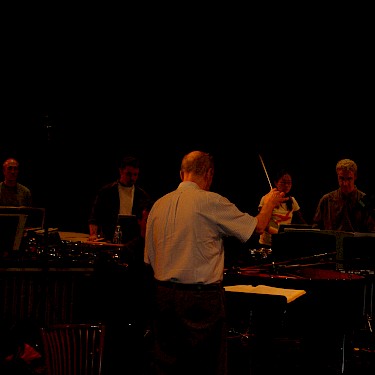Percussion Symphony
- Instrumentation
- p(22), pf(2)
- Year
- 1976
- Duration
- 38:00
The work is in three large movements, fast-slow-fast, in the traditional manner. But after Movement I, and again after Movement II, there is a quiet interlude. These "Entr'actes," as I call them, are transcriptions (reworkings) of the early Dufay setting (ca. 1430) of Petrarch's Vergine bella. The first is in moderate tempo, finalis on D, with pitched instruments only. The second is a slower reading of the same music, finalis now on E-flat, and with non-pitched instruments added. There are several considerations that prompted me to include these transcriptions. First, although there is no direct musical link between them and my own music, there do exist certain melodic affinities—especially between Entr'acte II and the last movement. Also, I have a long-standing avocation of "reworking" old music, and here for the first time I decided to incorporate the fruits of my "hobby" side by side with my "own" contribution—not collage but an integrated juxtaposition. However, the most compelling motive was to provide the relief afforded by light-textured and simple (but sophisticated) diatonicism, as a contrast and foil to the denser, louder contrapuntalities of the main movements. In this sense, the transcriptions stand outside the body of the Symphony itself, although they are always to be included in it.
The main movements are written using adaptations of methods I have described elsewhere. Beyond this, and the fact that their surfaces seem to me quite immediate and straight forward, little need be said about these movements but that they, along with the Entr'actes, follow a pitch-centric scheme which is taken from the work's twelve-tone set. Accordingly, the first movement proceeds from a centering on G-natural (the pitch class zero of the whole work) to end on a "split" between C and G. C having provided the lower fifth, the upper complement to G is introduced as the pitch level of Entr'acte I: D-natural. Movement II begins by referring to D, but finally ends centered on the tritone-related A-flat. Following the pattern of the first Entr'acte, the second now occurs at the upper fifth, this time E-flat. The last movement also begins at this pitch, winding its way back from E-flat, ultimately to reach the initial G-natural, the work's origin.
-CW
"Wuorinen's Percussion Symphony was the most astonishing piece, sustaining in its own inventive vitality and a listener's interest for a full 40 minutes. Aside from containing a lavish number of arresting thematic ideas, the Percussion Symphony is cunningly devised to engage the ear with shifting layers of pitched and unpitched sounds as they continually change perspectives in the most surprising and satisfying ways...'modernity and antiquity are pleasingly conjoined' in this wonderful piece, the best possible finale to an exciting concert of contemporary music." Peter Davis, New York Magazine
Recordings
-

Percussion Symphony
Presto CD (U.K.) | Amazon | iTunes | Spotify | YouTube Music
Interview with Paul Steenhuisen
Interview prior to Toronto performance of the PERCUSSION SYMPHONY (30 October 2011)

